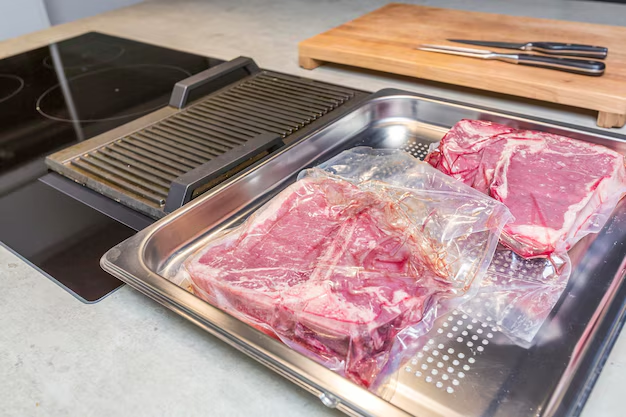How Long Can You Keep Lard in the Refrigerator? Find Out!
In a world buzzing with health trends and alternative cooking oils, lard somehow endures as a pantry classic—homeland of golden-crusted pies and flavorful frying. But if you've ever wondered, "how long does lard last in the refrigerator?", you’re not alone. Let’s dive into this quintessential kitchen staple and explore how to store it best, its shelf life, and how to tell when it’s time to let go.
🥄 The Basics of Lard and Its Culinary Role
Lard is a type of fat derived from pigs and is often used in baking, frying, and cooking. It's highly prized for its smooth texture and ability to produce tender, flaky baked goods, making it a sustained favorite in kitchens around the world. But how does its longevity match up, particularly when stored in the refrigerator?
Understanding Lard Varieties
- Rendered Lard: This is the basic form of lard used in many households and is usually what you’ll find at grocery stores. It's pure fat that's been filtered to eliminate any impurities.
- Leaf Lard: Considered the prized cut, leaf lard is gathered from the visceral fat around the kidneys and loin of the pig. It’s renowned for its neutral taste and is often used for baking.
- Hydrogenated Lard: This processed variety includes additives to improve shelf life and stability but can influence taste and texture.
Knowing which type of lard you're using aids in understanding its shelf life and how best to store it.
🗓️ How Long Does Lard Last in the Refrigerator?
While keeping lard in the refrigerator extends its life beyond that at room temperature, understanding its longevity is crucial for maximizing its use without compromising quality.
General Shelf Life in the Refrigerator
Typically, lard lasts about 6 months when refrigerated. This timeframe ensures its texture and flavor remain optimal. However, factors like storage conditions and packaging can influence longevity.
Factors Affecting Shelf Life
- Type of Lard: Natural rendered lard may last longer than heavily processed varieties.
- Storage Method: Airtight containers minimize exposure to air, reducing oxidation.
- Refrigerator Temperature: Consistent temperatures below 40°F (4°C) slow down degradation.
Does Freezing Extend Shelf Life?
Absolutely. If you freeze lard, you can extend its shelf life up to a year. Just ensure it's in an airtight container or vacuum-sealed bag to prevent freezer burn and preserve taste.
Signs That Lard Has Gone Bad
To determine if your lard has passed its prime, observe these telltale signs:
- Rancid Smell: A sharp, sour odor is a common sign of rancidity.
- Color Changes: Lard should be white or slightly off-white. Yellow or darker hues signal spoilage.
- Texture Alterations: Graininess or dryness may indicate degradation.
If in doubt, trust your senses—when lard has gone off, its flavor tells the story before it hits the pan.
🥶 Best Practices for Storing Lard
Ensuring lard is stored correctly keeps it fresh and optimizes shelf life. Here are practical storage tips:
Storage Tips
- Use Airtight Containers: This keeps out moisture and odors from the refrigerator.
- Label with Dates: Note the opening date to track freshness.
- Avoid Temperature Fluctuations: Store lard in the main body of the refrigerator rather than the door.
When Freezing, Remember:
- Divide into Portions: Consider portioning your lard to avoid thawing and refreezing.
- Wrap Properly: Use freezer paper for an added layer of protection.
🍽️ Using Lard Beyond Expiration
Even slightly aged lard can find a place in non-critical applications. Here’s how to use it rather than let it waste:
- Condition Cast-Iron Cookware: Use it to maintain or season cast-iron pans.
- DIY Projects: Create homemade soap or candles with older batches.
- Animal Feed: Consult local guidelines on using lard mixed with other feedstocks.
When freshness isn't of utmost importance, these options can prevent waste while putting lard to good use.
🧑🍳 Culinary Alternatives: When to Consider Other Fats
While lard offers unique qualities, there are contexts where alternatives might be preferable:
- Health Concerns: For those monitoring their saturated fat intake, oils like olive or avocado are common substitutes.
- Taste and Suitability: Butter and shortening can replicate some of the textural benefits of lard but with different flavors.
📋 Handy Summary for Lard Storage
To help you remember, here's a quick lard storage cheat sheet:
| Storage Method | Recommended Shelf Life | Notes |
|---|---|---|
| Refrigerator | Up to 6 months | Store in airtight containers |
| Freezer | Up to 12 months | Use airtight packaging to prevent freezer burn |
| At Room Temperature | 3-4 months | Keep in a cool, dark place for best results |
🐷 Key Tips:
- Keep an eye (and nose) out for changes in smell, color, or texture.
- Portion and freeze in airtight containers for extended storage.
- Explore versatile uses to reduce waste from expired or excess lard.
Closing Thoughts: Embrace Lard Smartly
Lard may come with its set of storage rules, but its culinary potential and ability to elevate dishes make it worthwhile. Follow the guidance above to ensure your lard lasts, avoid waste, and enjoy the flavors and textures this age-old staple brings to your table. Whether you're frying up a batch of homemade donuts or preparing a flaky pie crust, knowing how to store lard is key to keeping it at its best, maximizing both its shelf life and your culinary creations.
